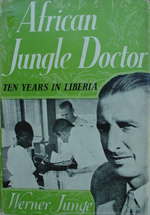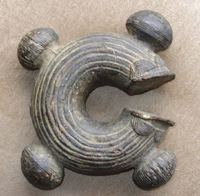|
1900-1950:
The Leopard Society in 'Vai country',
in Bassaland
During the Administration of President Edwin Barclay (1930-44) there were reports coming from various parts of the country, describing the gruesome and murderous activities of the 'leopard men'. One of these reports refers to the western part of Liberia. In 'African Jungle Doctor', a German doctor describes his ten years in Liberia. Dr Werner Junge went to Liberia in 1930 to establish a mission at Bolahun, in the heart of the jungle, and he spent two years in running the hospital there. He was then transferred to the coast, and carried on the same kind of work at Cape Mount until 1940. Dr Junge was confronted many times with activities of both the Crocodile Society and the Leopard Society. He extensively describes six cases of ritual murders or murder attempts which he had to deal with as a medical doctor. One of his experiences reads as follows: Dr Werner Junge went to Liberia in 1930 to establish a mission at Bolahun, in the heart of the jungle, and he spent two years in running the hospital there. He was then transferred to the coast, and carried on the same kind of work at Cape Mount until 1940. Dr Junge was confronted many times with activities of both the Crocodile Society and the Leopard Society. He extensively describes six cases of ritual murders or murder attempts which he had to deal with as a medical doctor. One of his experiences reads as follows:
"There, on a mat in a house, I found the horribly mutilated body of a fifteen-year-old girl. The neck was torn to ribbons by the teeth and claws of the animal, the intestines were torn out, the pelvis shattered, and one thigh was missing. A part of the thigh, gnawed to the bone, and a piece of the shin-bone lay near the body. It seemed at first glance that only a beast of prey could have treated the girl's body in this way, but closer investigation brought certain particularities to light which did not fit in with the picture. I observed, for example, that the skin at the edge of the undamaged part of the chest was torn by strangely regular gashes about an inch long. Also the liver had been removed from the body with a clean cut no beast could make. I was struck, too, by a piece of intestine the ends of which appeared to have been smoothly cut off, and, lastly, there was the fracture of the thigh - a classic example of fracture by bending." (Junge, 1952:
p. 176).
The Americo-Liberian representative of the government in Cape Mount - though he claimed to have stamped out the Leopard Society in Bassaland - was unable to unmask the perpetrators. Therefore, Junge directly sent his reports to the Minister of Interior in Monrovia. He was told, however, that further reports, or any interference on his part, were not desired 'in the interest of my own safety' (Junge, 1952:
p. 179). Desperately, the local population asked for help of paramount chiefs of more distant territories. In the end it was only after the intervention of one of them, a Gola chief, that the perpetrators were caught. Among those arrested was the head of a mission school, an old missionary who originated from Bassaland. "It was he who had brought this ancient and blood-thirsty religious order of the leopards from his native Bassaland, south of Monrovia, and revived it in Cape Mount, where this kind of human sacrifice had for long been extinct. For it was a case of ritual murder, (....)" (Junge, 1952:
p. 185).
To the astonishment of many, the Christian missionary was not punished. He stood trial but was not sentenced. The judge simply requested him to leave the district. Thus, he retired to his native Bassaland, where he died two years later (Junge, 1952:
p. 187).
Another source reports activities of 'leopard men' in Bassaland - during the early years of the Tubman Administration (1944-71). Again it is a foreign missionionary who describes what happened in 1946-47. Abe
Guenter spent some 35 years in Liberia, from 1945 till 1980, and was a missionary for the First Baptist Church. He mainly worked in the Suakoko area, in Central Liberia ('Bassaland'). Since he was a pilot and had a plane, he flew nearly all over the country. Thus, Abe
Guenter also preached in what he called 'Krahn country', in eastern Liberia, and on the coast between Buchanan, Grand Bassa County, and Greenville, Sinoe County. He had encounters with the Devil Society, Alligator Society, and many more. 1946-47. Abe
Guenter spent some 35 years in Liberia, from 1945 till 1980, and was a missionary for the First Baptist Church. He mainly worked in the Suakoko area, in Central Liberia ('Bassaland'). Since he was a pilot and had a plane, he flew nearly all over the country. Thus, Abe
Guenter also preached in what he called 'Krahn country', in eastern Liberia, and on the coast between Buchanan, Grand Bassa County, and Greenville, Sinoe County. He had encounters with the Devil Society, Alligator Society, and many more.
Guenter's religious convictions were deeply shocked upon arrival, in March 1946. He travelled to Suakoko village and described what he saw: "The villagers were mostly naked worshipers of idols, hills, rivers, ancestors and spirits."
(Guenter, 1992: p. 27). His zeal to christianize 'the heathens' would not fade during the following 35 years which were full of extraordinary experiences. Two of these are worth citing here. The first relates to the death of Chief Dabapa, presumably in a village north of Suakoko. "Some time before Chief Dapaba died, many people had disappeared from that area. While they crossed the river in a canoe, "leopard people" grabbed them, pulled them under the water, cut their heart out (for a sacrifice to their gods) and left the corpses. These "leopard people" would dress in leopard skins and put on claws of steel with which they stabbed their victims. Finally the chief called the big witch doctor to find out which men in his village were the leopard people. The big man came, mixed up some brew and made the suspected people drink his concoction. (Very likely,
Guenter describes here a kind of 'sasswood trial', a traditional Liberian method used to point out who is guilty of the committed crimes under investigation. - FVDK) Then they had to stand in a long line in the hot sun. After about ten minutes, two of the men began to weave around and then fell straight down on their faces. The witch doctor said, "There you have your men."
(Guenter, 1992: p. 55/56).
A second example of Guenter's experiences with traditional beliefs and a ritual killing relates to a village near the coast in 1947.
Guenter's book ('Jungle Pilot in Liberia') contains many references to his religious zeal and they occasionally evoke some scepticisme or even mistrust. However, what he describes in "They butchered a boy" is particularly interesting since he also describes a tradional object of which nowadays little is known. These objects are called 'Dwin', 'tien' or 'nitien', meaning water spirits, or 'Gods of water'. They are also known as
'Kru money'.
 Abe
Guenter: "I kept kept visiting that church from time to time to encourage and strengthen the believers. On one visit I noticed a ten-pound brass ring, 7 inches across and 1.5 inches thick with four knobs attached to the side. It was half buried in mud, so I pulled it out, cleaned it off and carried it to the deacon next door. "Deacon Carr, please tell me
what this is, " I requested. "Oh yes (....) I will tell you" he replied. "My grandfather was the big chief in this village. He was so afraid of spirits, sicknesses, war and other people's witchcraft that he went to the big, big witch doctor (....). With the help of the blacksmith, they poured this beautifully marked brass ring. (...) The witch doctor laid the ring down in the middle of the village (...). By then the sun was going down and the witch doctor had a meeting with just the elders of the village and my grandfather. He told them: "You asked for the most powerful witchcraft, and that always needs a human sacrifice. I want you to bring a young boy at
midnight to the new god so we can make this sacrifice." An eight-year-old boy, with his mouth gagged, was brought that night. They cut his throat and spilled all his blood on the brass ring, and from that time on, all the activities of the village revolved around the 'brass god': sacrifices, worship and all. But when the gospel came, we threw the ring away and turned to the true and living God."
(Guenter, 1992:
p. 58/59). Abe
Guenter: "I kept kept visiting that church from time to time to encourage and strengthen the believers. On one visit I noticed a ten-pound brass ring, 7 inches across and 1.5 inches thick with four knobs attached to the side. It was half buried in mud, so I pulled it out, cleaned it off and carried it to the deacon next door. "Deacon Carr, please tell me
what this is, " I requested. "Oh yes (....) I will tell you" he replied. "My grandfather was the big chief in this village. He was so afraid of spirits, sicknesses, war and other people's witchcraft that he went to the big, big witch doctor (....). With the help of the blacksmith, they poured this beautifully marked brass ring. (...) The witch doctor laid the ring down in the middle of the village (...). By then the sun was going down and the witch doctor had a meeting with just the elders of the village and my grandfather. He told them: "You asked for the most powerful witchcraft, and that always needs a human sacrifice. I want you to bring a young boy at
midnight to the new god so we can make this sacrifice." An eight-year-old boy, with his mouth gagged, was brought that night. They cut his throat and spilled all his blood on the brass ring, and from that time on, all the activities of the village revolved around the 'brass god': sacrifices, worship and all. But when the gospel came, we threw the ring away and turned to the true and living God."
(Guenter, 1992:
p. 58/59).
|
|
 Dr Werner Junge went to Liberia in 1930 to establish a mission at Bolahun, in the heart of the jungle, and he spent two years in running the hospital there. He was then transferred to the coast, and carried on the same kind of work at Cape Mount until 1940. Dr Junge was confronted many times with activities of both the Crocodile Society and the Leopard Society. He extensively describes six cases of ritual murders or murder attempts which he had to deal with as a medical doctor. One of his experiences reads as follows:
Dr Werner Junge went to Liberia in 1930 to establish a mission at Bolahun, in the heart of the jungle, and he spent two years in running the hospital there. He was then transferred to the coast, and carried on the same kind of work at Cape Mount until 1940. Dr Junge was confronted many times with activities of both the Crocodile Society and the Leopard Society. He extensively describes six cases of ritual murders or murder attempts which he had to deal with as a medical doctor. One of his experiences reads as follows: 1946-47. Abe
Guenter spent some 35 years in Liberia, from 1945 till 1980, and was a missionary for the First Baptist Church. He mainly worked in the Suakoko area, in Central Liberia ('Bassaland'). Since he was a pilot and had a plane, he flew nearly all over the country. Thus, Abe
Guenter also preached in what he called 'Krahn country', in eastern Liberia, and on the coast between Buchanan, Grand Bassa County, and Greenville, Sinoe County. He had encounters with the Devil Society, Alligator Society, and many more.
1946-47. Abe
Guenter spent some 35 years in Liberia, from 1945 till 1980, and was a missionary for the First Baptist Church. He mainly worked in the Suakoko area, in Central Liberia ('Bassaland'). Since he was a pilot and had a plane, he flew nearly all over the country. Thus, Abe
Guenter also preached in what he called 'Krahn country', in eastern Liberia, and on the coast between Buchanan, Grand Bassa County, and Greenville, Sinoe County. He had encounters with the Devil Society, Alligator Society, and many more. 